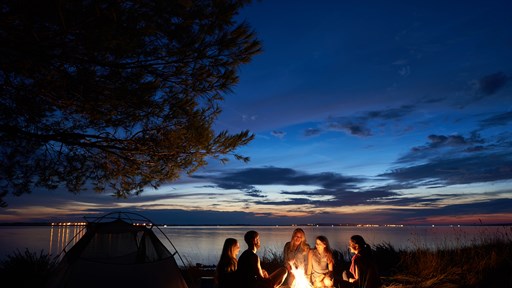You may have noticed circular outdoor yurt cabins popping up in campgrounds across the United States. These interesting structures resemble a cross between a tent and a cabin, and they have a rich history that dates back to ancient times. Originally from Central Asia, these shelters have become popular in the United States because many people find they can easily camp in a yurt to enjoy the best of tent and cabin features.
Whether you stay in a beach yurt or one in the mountains, a yurt weekend away is an exciting camping option. If you’re looking to enjoy the great outdoors in a traditional tent but still want access to additional cabin comforts and amenities, a yurt is a great combination of the two. Some yurts contain basic amenities, while others feature beds, kitchens and even bathrooms. Their round shape helps maintain comfortable temperatures and block wind, so they’re ideal for camping during any season.
What Is a Yurt?
A yurt is the modern version of an ancient shelter used by nomadic tribes in Central Asia. It’s a dome-shaped structure that resembles a tent but has a cabin’s durability. Yurts have circular wooden frames covered in felted wool layers, and along with other amenities, they can hold a stove to provide heat. Most yurts leave a small carbon footprint because they consist of natural materials, so they’re an eco-friendly shelter option.
Basic portable yurts can be assembled and taken down in one to three hours, while luxury yurts usually remain stationary. Yurts were traditionally used as portable homes for nomadic communities, and some populations still dwell in them full time. However, in the United States, yurts are popular among many people for luxury camping purposes.
The History of Yurts
Used by various ancient civilizations, yurts are one of the oldest types of shelters that we still utilize today. The yurt’s earliest known depiction is on a bronze dish dating back to approximately 600 BCE in Iran’s Zagros Mountains, but Siberia’s Buryat Mongolian community claims that their land is where the yurt originates. Herodotus, a Greek historian, even wrote about yurts that the Scythian community used around 440 BCE.
The Mongolians named this structure “ger,” which translates to “home” in English. Since Central Asian nomads traveled and moved several times a year, yurts made their journeys easier because they were easy to set up and tear down. Nomads used light materials to construct yurts, so two or three pack animals could easily haul them each time a community moved.
To obtain yurt construction materials, nomads would trade with merchants and woodworkers in river valleys. Merchants would offer wood at lower prices, pre-cut poles at higher prices and full yurts for the highest price. Nomads used felt or wool from their animals, such as goats, sheep and yak, to cover their yurts, which provided warmth and protection from outdoor elements.
Genghis Khan, a Mongolian leader, commanded the entire Mongolian empire from a large yurt and brought the yurt culture to new lands such as modern-day Hungary, Turkey and Romania as Mongol expanded its empire. Yurts remained popular in Turkey until the 1960s, and some citizens of Hungary still dwell in yurts today.
William Copperwaite first introduced yurts to the United States when he built one on Harvard’s campus as a first-year doctoral student in 1968. In 1978, Pacific Yurts became the first company to produce yurts in North America when they began constructing them for camping purposes. Yurts quickly became a more luxurious and convenient alternative to tents.
How Are Yurts Used Today?
According to National Geographic, over 50% of Mongolians still live in yurts today. Sixty-one percent of people in the Ulaanbaatar capital and 90% of the rural population dwell in yurts. Ulaanbataar and other large cities use tall fences to separate yurt quarters from other structural zones, and yurt dwellers live a much more communal lifestyle than people in the rest of the city. Large families often share yurts and meals, and community members often share bathhouses, saunas and spas since they are often disconnected from the city’s water supply.
Many communities in modern-day central Asia use yurts as structures for museums, cafes and cultural centers. Since yurts are an important part of Central Asian history and culture, many of them still have traditional decorative elements featuring cultural symbols, sacred traditions, mythic beasts and geometric patterns.
In the United States, yurts are popular for camping purposes, and some people even convert them into tiny homes. Some individuals choose to live in yurts because they cost less than regular homes and offer more freedom than owning a house.
Yurts Are Now a Trendy Way to Camp
Yurts are popular “glamping” options, which means they provide a camping experience with more luxury and convenience than a standard tent. Yurts allow you to sleep in nature, but many can also offer more space than tents and have amenities such as comfortable beds, kitchen appliances, bathrooms and electricity. Many yurts are also great for large groups because they can accommodate up to 15 people. If you want to plan a fun camping weekend for your whole family, a yurt is a great option.
When campers, hikers or vacationing families stay in a yurt, they don’t have to carry a ton of supplies with them because the yurt often contains most of what they will need. They can have a fun, relaxing experience in the great outdoors without pitching a tent or carrying a sleeping bag. Many campgrounds with yurts are located across the United States, providing unique camping experiences for families all over the country.
Portable yurts can be assembled and taken down within about an hour. While a portable yurt may not provide as many amenities as a luxury version, it still offers more comfort and space than a regular tent. Yurts’ circular shape exposes less surface space to outdoor temperatures and wind resistance. This means they provide plenty of warmth in the winter and keep you cool in the summer.
Try Yurt Camping at Kampgrounds of America
A yurt is a perfect mix between tent and cabin camping, and it provides a unique atmosphere. With their rich history, abundant space and convenient amenities, yurts can be an exciting adventure for your whole family. Enjoy the great outdoors in comfort. Many KOA Campgrounds offer clean restrooms, hot showers, laundry facilities, playgrounds and more.
At KOA, you can enjoy an affordable stay with friends and family and indulge in various family-friendly activities. Check out KOA locations to find a campground with available yurts to rent and book your next adventure.
About the Author: Kampgrounds of America
Kampgrounds of America is the largest system of open-to-the-public campgrounds in the world, with over 500 locations across the United States and Canada. Founded in Billings, MT in 1962, KOA’s family of campground brands – KOA Journey, KOA Holiday and KOA Resort – today serve more than a million camping families each year. KOA is dedicated to “connecting people to the outdoors and each other” by providing people with a variety of camping experiences and the information they need to make the most of their camping trip. Read more of their camping and travel resources by visiting KOA.com/blog.

























